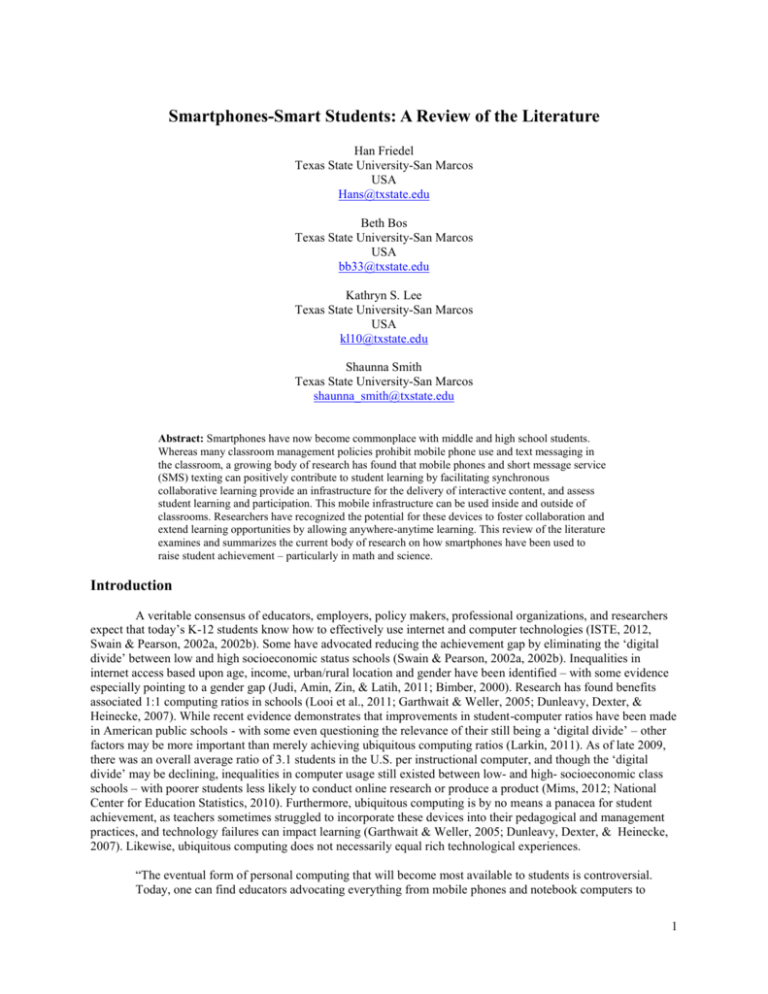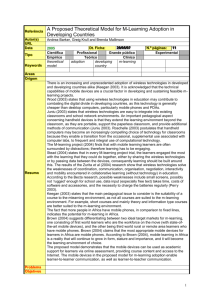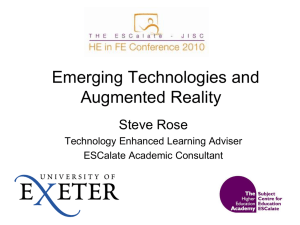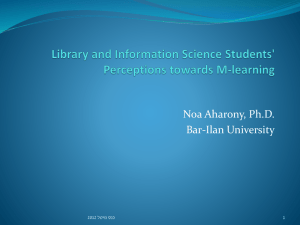Positive Impacts of Mobile Devices on Student Learning
advertisement

Smartphones-Smart Students: A Review of the Literature Han Friedel Texas State University-San Marcos USA Hans@txstate.edu Beth Bos Texas State University-San Marcos USA bb33@txstate.edu Kathryn S. Lee Texas State University-San Marcos USA kl10@txstate.edu Shaunna Smith Texas State University-San Marcos shaunna_smith@txstate.edu Abstract: Smartphones have now become commonplace with middle and high school students. Whereas many classroom management policies prohibit mobile phone use and text messaging in the classroom, a growing body of research has found that mobile phones and short message service (SMS) texting can positively contribute to student learning by facilitating synchronous collaborative learning provide an infrastructure for the delivery of interactive content, and assess student learning and participation. This mobile infrastructure can be used inside and outside of classrooms. Researchers have recognized the potential for these devices to foster collaboration and extend learning opportunities by allowing anywhere-anytime learning. This review of the literature examines and summarizes the current body of research on how smartphones have been used to raise student achievement – particularly in math and science. Introduction A veritable consensus of educators, employers, policy makers, professional organizations, and researchers expect that today’s K-12 students know how to effectively use internet and computer technologies (ISTE, 2012, Swain & Pearson, 2002a, 2002b). Some have advocated reducing the achievement gap by eliminating the ‘digital divide’ between low and high socioeconomic status schools (Swain & Pearson, 2002a, 2002b). Inequalities in internet access based upon age, income, urban/rural location and gender have been identified – with some evidence especially pointing to a gender gap (Judi, Amin, Zin, & Latih, 2011; Bimber, 2000). Research has found benefits associated 1:1 computing ratios in schools (Looi et al., 2011; Garthwait & Weller, 2005; Dunleavy, Dexter, & Heinecke, 2007). While recent evidence demonstrates that improvements in student-computer ratios have been made in American public schools - with some even questioning the relevance of their still being a ‘digital divide’ – other factors may be more important than merely achieving ubiquitous computing ratios (Larkin, 2011). As of late 2009, there was an overall average ratio of 3.1 students in the U.S. per instructional computer, and though the ‘digital divide’ may be declining, inequalities in computer usage still existed between low- and high- socioeconomic class schools – with poorer students less likely to conduct online research or produce a product (Mims, 2012; National Center for Education Statistics, 2010). Furthermore, ubiquitous computing is by no means a panacea for student achievement, as teachers sometimes struggled to incorporate these devices into their pedagogical and management practices, and technology failures can impact learning (Garthwait & Weller, 2005; Dunleavy, Dexter, & Heinecke, 2007). Likewise, ubiquitous computing does not necessarily equal rich technological experiences. “The eventual form of personal computing that will become most available to students is controversial. Today, one can find educators advocating everything from mobile phones and notebook computers to 1 Tablet PCs and personal digital assistants (PDAs). In addition to these general-purpose computing devices, many researchers advocate specialized designed-for-learning devices” (Chan et al., 2006, p. 5). Recent developments in mobile devices have promised to make the goal of ubiquitous computing a reality (Garthwait & Weller, 2005; Zucker, 2004; Van ‘T Hooft & Swan, 2004; Swain & Pearson, 2002a, 2002b). Personal computing, interactive communication, and accessing the internet, once the domain of notebook computers, palm pilots, and PDA’s, is now being overtaken by smartphones and tablets (Greifner, 2007; Hirsch, 2007; Bomar, 2006; Hastings, 2005). Certainly, personal computing, communication, and internet access is becoming more mobile. This anytime-anywhere access can go beyond mere mobile browsing, SMS, and wireless communication, as a number of current smartphones on the market operate the Microsoft Windows 7 Operating System (Microsoft, 2012). There are social justice implications as students without high speed internet and home computing resources could increase digital literacy without needing to access expensive personal computers. Mobile Devices Overtaking Personal Computers Recently, those interested in ubiquitous computing have become increasingly interested in the impact of handheld mobile devices such as smartphones, iPods, and tablets on student learning. Smartphones have now become commonplace with middle and high school students. Recent results from an extensive survey of 5,600 U.S. high school students found that 34% owned an iPhone, an all-time high doubling the previous year’s percentage. Furthermore, 40% of those surveyed indicated intent to purchase an iPhone within the next six months (ElmerDeWitt, 2012). Perhaps nothing better illustrates the mobile trend and increasing ubiquity of these progressively powerful devices - than the “significant milestone” that global smartphones sales overtook global sales of total personal computers across all client categories (netbooks, notebooks, pads, and desktops) in 2011 by a wide margin – 487.7 million to 414.6 million units (Canalys, 2012). Global smartphone sales increased 62.7% from 2010 to 2011, compared with a more tepid global increase in computer sales of 14.8% (all categories) during the same interval. There were a staggering 4.6 billion mobile cellular subscriptions in effect globally by the end of 2009 (International Telecommunication Union, 2010). Perhaps there is a growing disconnect between today’s tech savvy students and their school’s prevailing assumptions, practices, and pedagogies regarding technology in the classroom (Levin & Arafeh, 2002; Prenksy, 2001). While there is perhaps a mismatch between classroom management policies and the tremendous potential of these devices, a growing body of research has found that mobile phones and short message service (SMS) texting can positively impact student learning by facilitating synchronous collaborative learning, provide an infrastructure for the delivery of instructional content, and a means to assess student learning and participation (Friedel, 2011; Hirsch, 2007). This mobile infrastructure has been used to positively impact student learning inside and outside of classrooms (Lin, Shao, Wong, Li, & Niramitranon, 2011). Researchers have recognized the potential for these devices to foster collaboration and extend learning opportunities by allowing “learning everywhere; when walking, in the street, on the bus, in the school, or even on the subway” (Sánchez & Olivares, 2011, p. 1943). Some researchers have even suggested that mobile handheld devices may better support student learning than traditional desktop computers because of wireless connectivity, portability, and comparative low cost (White, 2006). Consistent with these findings, researchers have pointed to the value of further investigating the incorporation of mobile phones and their capabilities in technology-enhanced education (Markett, Sánchez, Weber, & Tangney, 2006). The ability to take and send pictures has implications as well: “Due mainly to advances in cognitive science, philosophers today increasingly recognize that we do indeed have the capacity of thinking directly with images, without verbal mediation” (Nyíri, 2002, p. 3). From E-learning to M-learning Students, but not necessarily schools, are making the transition from e-learning to new m-learning literacies (Georgiev, Georgieva, Smrikarov, 2004). E-learning can be broadly defined as content designed for access through electronic communication, such as the Internet, intranets, synchronous and asynchronous modules (Crescente & Lee, 2011). M-learning extends the notion of e-learning further by adapting its content to handheld devices, and can therefore be broadly defined as learning with mobile devices anywhere and anytime (Crescente & Lee, 2011). This ability to assimilate learning anywhere and at any time means learners are no longer confined by static resources like a desktop computer (Crescente & Lee, 2011; Mellow, 2010). It has even been suggested that notebook computers are not anywhere, anytime machines and should therefore be excluded as true m-learning devices (Crescente & Lee, 2011). M-learning offers benefits over traditional and e-learning in that information is accessible anywhere, devices 2 are highly portable, knowledge continuously updated, collaborative instantaneous, participation synchronous, and literacy (especially technological) improved (Ozdamli, 2012). The capability of mobile devices to download and host a virtually infinite number of specialized, tiny software packages known as ‘apps’ lends an inherent flexibility in these devices as learner-centered tools – with apps functionality can go far beyond communication and photography. Apps are small, specialized, and downloadable programs for mobile devices that function much the way software programs do on traditional personal computers (Dictionary.com, 2012). There are native, web-based, and hybrid apps. Native mobile apps use the native programming language for their platform, such as Objective-C for iPhone or iPad or Java for Android (Xcube Labs, 2012). Native apps are faster, interface with users better, and have access to all device features. On the down side, they can be used only on a specific platform, thereby restricting their scope. Web apps are website built using programming languages such as HTML5, resembles other applications, and can be accessed through mobile browsers (Xcube Labs, 2012). Though web apps can be used across all platforms and devices, they are not accepted in the native app stores - limiting their distribution. Also, web apps cannot access or use the native application programming interfaces (APIs) or some device specific hardware features. A middle ground is achieved with hybrid aps, which are built using web technology and then wrapped in platform-specific shells. These not only makes them look like native apps and eligible to enter app stores, but allows developers to build in limited native functionalities including access to some native APIs and use of certain device-specific hardware features (Xcube Labs, 2012). The inherent flexibility in being able to download a plethora of native, web, and hybrid apps underscores the tremendous potential mobile devices have to transform education – especially science, technology, engineering, and math (STEM) education (Banister, 2010). Just recently, an article appeared online entitled “5 New Apps to Spur STEM Learning” (Noonoo, 2012). Positive Impacts of Mobile Devices on Student Learning Mobile devices have been used effectively within classroom environments to augment traditional student learning and instruction. Ktoridou and Eteokleous (2005) identified device integration as a potentially both a supportive tool and as an instructional tool. Mobile devices support communication between learners, teachers, provides file sharing, discussion, information search, and other features. Also mobile tools can use as an instructional tool. For example students execute their learning tasks on mobile devices. Instructors can give students e-books, content, and other learning materials (Ozdamli, 2012). Educational researchers have incorporated these devices into the framework of otherwise traditional classes to teach lessons, deliver course materials, scaffold learning, and assess student knowledge, skills, and learning (Ozdamli, 2012; Chang, Chen, Hsu, 2011; Thornton & Houser, 2005; Facer et al. 2003). These researchers have conducted experiments that demonstrated the effectiveness of sending short vocabulary lessons to the smartphones of Japanese English as a foreign Language (EFL) college students - compared with control group peers who received the same lessons via traditional or online means, to teach elementary school children about animal survival within the context of an environment, to each middle school students about the environment itself, to improve spatial reasoning and learn geometric concepts through a mobile game, and to teach 3rd graders general science lessons (Facer et al. 2003; Thornton & Houser, 2005; Looi et al., 2010; Chang, Chen, & Hsu, 2011). Mobile devices and their capabilities are particularly well suited for science instruction (Roschelle, Penuel, Yarnall, Shechtman, & Tatarw, 2005). Important, the educational use of handheld digital devices has direct implications supporting constructivist science classrooms by leading to higher participation levels – particularly in inquiry-, problem-based, and collaborative environments (Lin et al., 2011; Markett et al., 2006; White, 2005; Davis, 2003). These higherparticipation levels are facilitated through networked mobile devices in a number of ways. First, they raise increase participation equity by allowing shy students to be publicly anonymous while remaining privately accountable for their participation within a classroom (Davis, 2003). Second, they make synchronous parallel participation possible within a whole-class or group environment (White, 2006; Davis, 2003). The ability for shy students to remain publicly anonymous while privately accountable within the classroom increases equity in participation and allows all students the ability to participate in a whole-class setting equally (Davis, 2003). Finally, their small size and portability enables students to interact with each other and their teachers, access information, and upload data from virtually any authentic setting (Sánchez & Olivares, 2011; Looi et al., 2010). This anywhere/anytime access provides for technology-mediated learning from within- and without- of class settings (Looi et al., 2010). M-learning requires an Applied Pedagogy for STEM Classrooms 3 Despite m-learning’s compatibility with constructivist learning theories, including obvious inquiry-based, problem-based, and cooperative implications, sophisticated 21st century mobile infrastructure warrants an equally sophisticated pedagogy - especially one supporting their use in- and out of science, technology, engineering, and math (STEM) classrooms. A mobile pedagogy for how to best use these devices in and out of STEM classes is in its very nascent stages (Muyinda, 2007). “Situation-dependent knowledge, the knowledge at which m-learning aims, by its nature transcends disciplines; its organizing principles arise from practical tasks; its contents are multisensorial; its elements are linked to each other not just by texts, but also by diagrams, pictures, and maps. …science today is ready to meet the needs of m-learning” (Nyíri, 2002, p. 5). Still, the foundations for an m-learning pedagogy are being postulated. Mayinda (2007) citing Sharples, Taylor, and Vavoula (2005) identified as pre-requisites for the formulation of an m-learning theory that one must distinguish between what is unique about m-learning compared with other types of learning; determine and embrace the amount of learning that occurs outside of the classroom under the auspices of m-learning; consider contemporary theories such as learner centeredness, knowledge centeredness, assessment centeredness, and community centeredness; and account for the ubiquity of personal and shared technology (Mayinda, 2007; Sharples, Taylor, & Vavoula, 2005). Similarly, Koole (2005) developed a model for the Rational Analysis of Mobile Education (FRAME) to assess the effectiveness of mobile devices for distance learning based upon constructivist notions that learning occurs through cognition and social interaction (Crescente & Lee, 2011; Koole, 2005). FRAME was illustrated by Venn diagram of three interlocking circles illustrating, (A) device usability, (B) learner aspects, and (C) social aspects. Device usability pertains to the functionality of the mobile devices, learner aspects refer to the cognitive skills and prior knowledge of learners, and social aspects emphasizes individual reactions to the shared environment. Where all factors converge (ABC), mobile learning would become practical (Crescente & Lee, 2011; Koole, 2005). Still, a generally agreed upon mobile pedagogy is still lacking in the literature – not to mention a body of research-based, applied m-learning STEM lesson plans for classroom teachers! Nevertheless, Ozdamli (2012) identified four aspects for at least a pedagogical framework for mobile learning. These were integration of tools, pedagogical approaches, assessment techniques, and teacher training. Theory-based approaches, such as constructivism, blended learning, collaborative learning, and active learning have been suggested for the basis of a new m-learning pedagogy (Ozdamli, 2012). One teacher utilized a studio-based pedagogy with smartphones in a secondary social studies classroom: “During the place-based inquiry workshop, students used the built-in features of mobile devices (for example, audio recording, text messaging, GPS, cameras) and “off the shelf” software to investigate their city as a designed place. In order to introduce students to this concept and scaffold their initial investigations, we developed a simulation that invited them to role-play as consultants hired by the city to locate contested places and issues within the downtown area. As they walked around town in pairs, looking for, observing and analyzing contested places, the students used mobile devices to conduct interviews, take photos, access “just-in-time” information, and record notes” (Mathews 2010, p. 89). One would be hard pressed to walk into an average K-12 classroom in the U.S. and see smartphones out and in use ‘on’ the desks instead of clandestinely texting ‘under’ them. There is a gap in the literature between recognizing the benefit potential of m-learning and outlining a clear pedagogy for how K-12 classroom teachers could incorporate it in their practice. What conversations would an educator or administrator have with students, administrators, and parents? Would school policy changes be required? Further research is needed on how to help teachers learn how to effectively use these technologies in assessment-centered learning environment (Garthwait & Weller, 2005). Such pedagogy would translate accepted theory into best-practices, and would delve deeper into smartphone’s evolving computing, networking, and communication capabilities. The pieces of the puzzle are falling into place, as there are already a number of websites and blogs identifying must-have education apps (Fleming, 2012; Freeman, 2012). One thing is certain, these increasingly capable mobile devices and their ability to mediate anywhere/anytime learning has the power to transform STEM education, pedagogical practice, and notions of ubiquitous computing in public schools. More research is needed to (a) develop theory-based, practical pedagogies and polices for the incorporation of mobile devices and educational apps into K-12 STEM classrooms; to (b) develop one or more STEM apps for 4 smartphone devices based the pedagogies they identify; and to (c) fund a pilot study incorporating these pedagogies, practices, and technologies into their classrooms; and (d) to explore creating new collaborative roles for students and teachers within the anytime-anywhere mobile environment. The overarching goal of the symposium and pilot study being to bridge the wide gap between the literature, theory, and reality in bringing smartphones into the open in public school classrooms – and further eliminate the digital divide both in class and at home. References Banister, S. (2010). Integrating the iPod touch in K–12 Education:Visions and vices. Computers in the Schools, 27. 121–131 Bimber, B. (2000). The gender gap on the internet. Social Science Quarterly, 81(3), 868-876. Bomar, L. (2006). iPods as reading tools. Principal, 85(5), 52–53. Brown, T. (2005). Towards a model for m-learning in Africa. International Journal on E-Learning, 4(3), 299-315. Canalys. (2012). Smart phones overtake client PCs in 2011. Available from http://www.canalys.com/newsroom/smart-phones-overtake-client-pcs-2011 Chan, T., Roschelle, J., Hsi, S., Sharples, M., Brown, T. O. M., & Patton, C. (2006). One-to-one technologyenhanced learning: An opportunity for global research collaboration. Research and Practice in Technology Enhanced Learning, 1, 3-29. Chang, C., Chen, T., & Hsu, W. (2011). The study on integrating WebQuest with mobile learning for environmental education. Computers & Education, 57(1), 1228-1239. Crescente, M.L., Lee, D. (2011). Critical issues of m-learning: design models, adoption processes, and future trends. Journal of the Chinese Institute of Industrial Engineers, 28(2), 111-123. Davis, S. (2003). Observations in classrooms using a network of handheld devices. Journal of Computer Assisted Learning, 19(3), 298–307. Dictionary.com. (2012). Available from http://dictionary.com Dunleavy, M., & Heinecke, W. (2007). The Impact of 1:1 laptop use on middle school math and science standardized test scores. Computers in the Schools, 24(3/4), 7-22. Elmer-DeWitt, P. (2012). Teen survey: 34% own an iPhone, 40% want one. CNN Money. Available from http://tech.fortune.cnn.com/2012/04/03/teen-survey-34-own-an-iphone-40-want-one/ Facer, K., Joiner, R., Stanton, D., Reid, J., Hull, & Kirk, D. (2004). Savannah: Mobile gaming and learning. Journal of Computer Assisted Learning, 20, 399-409. Fleming, R. (2012). Top 5 education apps that will be developed in the Cloud with Windows Azure. Microsoft, Education Blog. Available from http://blogs.msdn.com/b/education/archive/2012/06/12/top-5-education-appsthat-will-be-developed-in-the-cloud-with-windows-azure.aspx Freeman, A. (2012). 5 Must-Have Education Apps. Take Part. Available from http://www.takepart.com/article/2012/06/05/5-must-have-education-apps Friedel, H. (2011). The impact of mobile handheld digital devices on student learning. Unpublished, Texas State University. International Society for Technology in Education (ISTE). (2004). Available from http://www.iste.org Garthwait, A., Weller, H. (2005). Year in the life: Two seventh grade teachers implement one-to-one computing. Journal of Research on Technology in Education, 37(4), 361-377. Georgiev, T., Georgieva, E. and Smrikarov, A. (2004). M-learning - a new stage of e-learning, International Conference on Computer Systems and Technologies - CompSysTech’2004, Rousse, Bulgaria, 17-18 June 2004. Available from http://ecet.ecs.ru.acad.bg/cst04/Docs/sIV/428.pdf. Greifner, L. (2007). iPods and cellphones. Education Week, Gadgets & Games. Available from http://www.edweek.org/dd/articles/2007/06/20/01sr_gadgets.h01.html Hastings, J. (2005). Cool tools. School Library Journal, 51(9), 42–45. Hirsch, J. (2007). What’s that in your students’ pockets? School Administrator, 64(7), 8. International Telecommunication Union. (2010). Measuring the information society. Available from www.itu.int/ITU-D/ict/publications/idi/2010/ Material/MIS_2010_Summary_E.pdf Judi H.M., Amin, H.M., Zin, N.A.M., & Latih, R. (2011). Rural students’ skills and attitudes towards information and communication technology. Journal of Social Sciences, 7 (4): 619-626. Koole, M. L. (2005). The framework for the rational analysis of mobile education (FRAME) model: An evaluation of mobile devices for distance education. Unpublished master’s thesis. Athabasca University. Available from http://library.athabascau.ca/drr/viewdtr.php?course=thes&id=205 5 Ktoridou, D., & Eteokleous, N. (2005). Adaptive m-learning: Technological and pedagogical aspects to be considered in Cyprus tertiary education. Proceedings of the 3rd International Conference on Multimedia and Information and Communication Technologies in Education (m-ICTE2005). Larkin, K. (2011). You use! I use! We use! Questioning the orthodoxy of one-to-one computing in Primary Schools. Journal of Research on Technology in Education, 44(2), 101-120. Levin, D., & Arafeh, S. (2002). The digital disconnect: The widening gap between internet savvy students and their schools. The Pew Internet & American Life Project, 2002. Lin, C., Shao, Y., Wong, L., Li, Y., & Niramitranon, J. (2011). The impact of using synchronous collaborative virtual tangram in children's geometric. Turkish Online Journal of Educational Technology, 10(2), 250-258. Looi, C., Zhang, B., Chen, W., Seow, P., Chia. G., Norrist, C., & Soloway, E. (2010). 1:1 mobile inquiry learning experience for primary science students: A study of learning effectiveness. Journal of Computer Assisted Learning, 27, 269-287. Markett, I., Sánchez, A., Weber, S., & Tangney, B. (2006). Using short message service to encourage interactivity in the classroom. Computers & Education, 46(3), 280-293. Mathews, J. M. (2010). Using a studio-based pedagogy to engage students in the design of mobile-based media. English Teaching: Practice and Critique 9(1), 87-102. Mellow, P. (2010). The media generation: maximize learning by getting mobile. Proceedings for ASCILITE 2005 Conference: Balance, Fidelity, Mobility: maintaining the momentum? December 4-7, Brisbane, Australia. Available online at: www.ascilite.org.au/conferences/brisbane05/ blogs/proceedings/53_Mellow.pdf Microsoft. (2012). WindowsPhone. Available from http://www.microsoft.com/windowsphone/enus/buy/7/default.aspx Mims, C. (2012). There is no digital divide. Technology Review. Available from http://www.technologyreview.com/view/428043/there-is-no-digital-divide/ Muyinda, P.B. (2007). MLearning: pedagogical, technical and organizational hypes and realities. Campus-Wide Information Systems 24(2), 97–104. National Center for Education Statistics. (2010). Teachers' Use of Educational Technology in U.S. Public Schools: 2009. U.S. Department of Education. Available from http://nces.ed.gov/pubsearch/pubsinfo.asp?pubid=2010040 Noonoo, S. (2012). 5 new apps to spur STEM learning. Available from http://thejournal.com/articles/2012/02/06/5new-apps-to-spur-stem-learning.aspx Nyíri, K. (2002). Towards a philosophy of m-learning. IEEE International Workshop on Wireless and Mobile Technologies in Education (WMTE 2002), August 29-30, 2002, Teleborg Campus, Växjö University, Sweden. Olivera, K., & Corn, J. (2008). Student-reported differences in technology use and skills after the implementation of one-to-one computing. Educational Media International, 45(3), 215–229. Ozdamli, F. (2012). Pedagogical framework of m-learning. Procedia - Social and Behavioral Sciences 31, 927 – 931. Prenksy, M. (2001). Digital natives, digital immigrants. On the Horizon, 9(5), 1–6. Roschelle, J., Penuel, W., Yarnall., L., Shechtman, N., & Tatarw, D. (2005). Handheld tools that ‘Informate’ assessment of student learning in Science: a requirements analysis. Journal of Computer Assisted learning 21, 190–203. Sánchez, J., & Olivares, R. (2011). Problem solving and collaboration using mobile serious games. Computers & Education, 57(3), 1943-1952. Sharples, M., Taylor, J. and Vavoula, G. (2005), Towards a theory of mobile learning. Proceedings of the 4th World Conference on Mlearning (MLearning 2005), SA, 25-28 October. Swain, C., & Pearson, T. (2002a). Educators and technology standards: Influencing the digital divide. Journal of Research on Technology in Education, 34(3), 326–335. Swain, C., & Pearson, T. (2002b). Educators and technology standards: Influencing the digital divide. Journal of Research on Technology in Education, 34(3), 13–29. Thornton, P., & Houser, C. (2005). Using mobile phones in English education in Japan. Journal of Computer Assisted Learning, 21(3), 217-228. Van ‘T Hooft, M. E., & Swan, K. E. (2004). Ubiquitous Computing. Journal of Educational Computing Research, 30(4), 275–279. White, T. (2006). Code talk: Student discourse and participation with networked handhelds. International Journal of Computer-Supported Collaborative Learning, 1(3), 359-382. Xcube Labs. (2012). Native, web, and hybrid apps – Understanding the difference. http://www.xcubelabs.com/blog/native-web-and-hybrid-apps-understanding-the-difference/ 6 Zucker, A., & Hug, S. (2008). Teaching and learning physics in a 1:1 laptop school. Journal of Science Education Technology, 17, 586–594. 7






